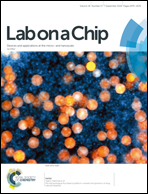Hydrogel-incorporating unit in a well: 3D cell culture for high-throughput analysis†
Abstract
The microfluidic 3D cell culture system has been an attractive model because it mimics the tissue and disease model, thereby expanding our ability to control the local cellular microenvironment. However, these systems still have limited value as quantitative assay tools due to the difficulties associated with the manipulation and maintenance of microfluidic cells, and their lack of compatibility with the high-throughput screening (HTS) analysis system. In this study, we suggest a microchannel-free, 3D cell culture system that has a hydrogel-incorporating unit integrated with a multi-well plate (24- to 96-well plate), which can provide better reproducibility in biological experiments. This plate was devised considering the design constraints imposed by various cell biology applications as well as by high-throughput analysis where the physical dimensions of the micro-features in the hydrogel-incorporating units were altered. We also demonstrated that the developed plate is potentially applicable to a variety of quantitative biochemical assays for qRT-PCR, Western blotting, and microplate-reader-based assays, such as ELISA, viability assay, and high content-screening (HCS) as well as the co-culture for biological studies. Human neural progenitor cells (hNPCs) that produce pathogenic Aβ species for modeling Alzheimer's disease (AD) were three-dimensionally cultured, and the efficacy of the inhibitors of Aβ production was assessed by ELISA in order to demonstrate the performance of this plate.



 Please wait while we load your content...
Please wait while we load your content...